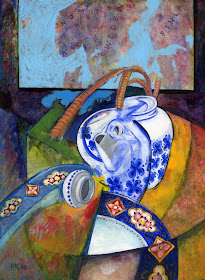N.B., Click on images to zoom.
Still Life with White Porcelain
Oil Painting on Panel
Some painters ( Magritte may be a decent example of this) stay with one painting approach all their working lives.
Others, such as Max Ernst, move around from style to style, almost frenetically. And yet others, such as De Chirico, work in one distinct style and change to another for the rest of their working career.
Chances are, I'm closest to De Chirico on this one.
Up to (about) ten years ago I used to paint with a completely different approach to the one I have use now. I was fascinated by the late Cubists. I loved (and still do) the 'hermetic' phase of Cubism, but I came to prefer what was known as the 'synthetic' (from synthesis) phase.
In particular I was sympathetic to the work of Juan Gris, the third (after Picasso and Braque) of the main Cubists.
This posting shows some of the work that I produced during this period.
Others, such as Max Ernst, move around from style to style, almost frenetically. And yet others, such as De Chirico, work in one distinct style and change to another for the rest of their working career.
Chances are, I'm closest to De Chirico on this one.
Up to (about) ten years ago I used to paint with a completely different approach to the one I have use now. I was fascinated by the late Cubists. I loved (and still do) the 'hermetic' phase of Cubism, but I came to prefer what was known as the 'synthetic' (from synthesis) phase.
In particular I was sympathetic to the work of Juan Gris, the third (after Picasso and Braque) of the main Cubists.
This posting shows some of the work that I produced during this period.
N.B., Click on images to zoom.
Jug with Maya panel
Oil Painting on Panel
Most of the stuff I did during this period was discarded when I had my re-think. In 2003 I headed up to Enfield dump to get rid of lots the paintings. Some of them were worth painting over so as to keep the supports, in particular any decent canvas and stretcher.
And a few of them, (like most of the one's below), I kept simply as mementoes of time past.
And a few of them, (like most of the one's below), I kept simply as mementoes of time past.
N.B., Click on images to zoom.

Map and Teapot
Oil Painting on Panel
They were largely still-lives. I usually held the crockery or whatever the main objects were, in my left hand, turning it round and round, while I painted it from different angles.
The backgrounds tended to have two-dimensional pikkies, like the map above, or the Maya-style images in the painting above that.
The backgrounds tended to have two-dimensional pikkies, like the map above, or the Maya-style images in the painting above that.
N.B., Click on images to zoom.
Still Life
Fruit (stage 1)
Fruit (stage 2)
Fruit (stage 2)
Jug and Flowers
Oil Painting on Panel
From the Weitz Collection
From the Weitz Collection
Here's a three-part stages sequence....
Oil Painting on Panel
This demonstrates the simplicity of the painting method. Using a still life as a visual prompt, I would loosely block in the basic composition, fairly broadly, in monochrome, as here.
Oil Painting on Panel
Next I would block in some colour. Again, fairly broadly, and occasionally (if I was working on a panel) I would use acrylics (as I have done here), so that they would dry quickly, and then I could get on almost immediately with the final stage - painting over in oil.
Fruit (stage 2)
Oil Painting on Panel
I would then paint the final surface in oil paint. Most of the painting was pretty well intuitive, taking some, but not much, congnisance of the still life in front of me. As can be seen, the colour became arbitrary and the composition was largely invented.
Jug and Flowers
Oil Painting on Panel
However, as I have explained in a previous posting, I realised that most of this stuff was not really honest. I felt that I was looking at other art rather than nature.
So, in 2003 I headed up to Enfield dump to get rid of lots the paintings. A few of them had decent supports, particularly canvas and stretcher, so they have been painted over. And a small group of them, i.e., these reproduced here, I kept simply as mementoes of time past.
___________________________________________________________________
quiz quiz quiz “details, details............” quiz quiz quiz
In which painting does this farming scene appear, and who painted it?
And here's the answer from the last posting -
'The Toilet of Venus ('The Rokeby Venus').
Diego Velázquez. 1647-51.
Diego Velázquez. 1647-51.
quiz quiz quiz quiz quiz quiz quiz quiz quiz quiz quiz quiz quiz quiz quiz quiz
"Nothing is said that has not been said before."
Terence








